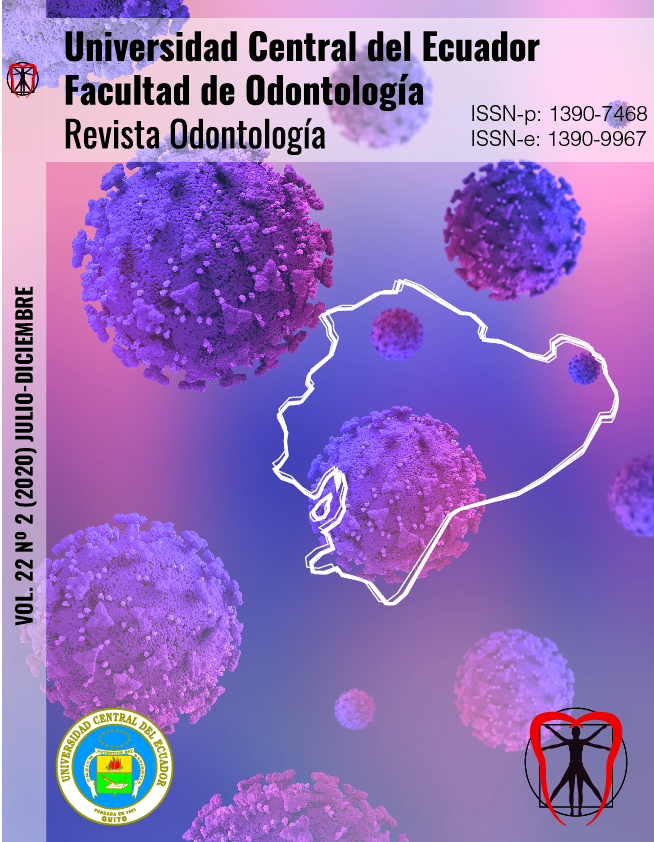Cyclical fatigue of four reciprocating systems in a dynamic dump of simulating roots
DOI:
https://doi.org/10.29166/odontologia.vol22.n2.2020-45-59Keywords:
Root canal, cyclic fatigue, material resistance, flexural strength, mechanical stressAbstract
In the curved canals, the use of files that avoid deviations and fractures of the instrument due to fatigue and that maintain original curvatures are important aspects in endodontic treatment. Objective: The resistance to cyclic fatigue of four reciprocating systems was evaluated in a dynamic gutter that stimulated three different curvatures. Materials and Method: In vitro study, the sample with 48 files was divided into four groups (n = 12 /group): WaveOne® (WO), WaveOne® Gold (WOG), Reciproc® (R) and Reciproc® Blue (RB), four files from each system were used in a gutter that simulated three angulations 45o , 60 o and 90 o . The files which were mounted on an X-smart Plus® were inserted 23 mm into the conduits to be continuously activated at 300/500 oscillations per minute until the fracture occurred. Time and fracture zone were recorded. The Krustal Wallis test was performed with a 95% confidence level for the comparisons. Results: RB presented greater resistance to cyclic fatigue than WO and WOG at 45o and 60o, however, at 90o WOG was higher than R and WO (p<0.05). There were no differences regarding the fracture zone occurred in the apical portion. Conclusions: The resistance decreases when the degree of curvature increases. RB was significantly more resistance to cyclic fatigue than WO and WOG at all angulations and R at 90o. The fracture zone occurred in the apical portion of the files.
Downloads
References
Weine F. Tratamiento endodoncia. quinta edición ed. Madrid: Editorial Harcourt Brace; 1997.
Hulsmann M, Peters O, Dummer P. Mechanical preparation of root canals: shaping goals, techniques and means. Endodontic Topic. 2005; 10(1): p. 30-76.
Soares J, Goldberg F. Endodoncia técnica y fundamentos. primera edición ed. Argentina: Editorial Médica Panamericana; 2002.
Rodríguez YE. Aleación de Níquel-Titanio y su uso en Endodoncia. Acta Odont. Venez. 2000; 38(1): p. 1-4.
Soares J, Goldberg F. Endodoncia Técnica y Fundamentos Madrid: Editorial Médica Panamericana; 2002.
Fernández Y, Mendiola C. Evolución de los sistemas rotatorios en endodoncia: propiedades y diseño. Rev Estomatol Herediana. 2011; 21(1): p. 51-54.
Mohammad RN, Sedigh-Shams M, Abdolrasoulnia S. Cyclic Fatigue Life of Two Single File Engine-Driven Systems in Simulated Curved Canals. IEJ. 2018; 13(1): p. 61-65.
Gaitán C, Lara E, Flores H, Pozos A, Méndez V. Current Challanges and Concepts of the Thermomechanical Treatment of Nickel-Titanium Instruments. Odonvtos-Int. J. Dental. 2017; 19(1): p. 51-58.
Iacono F, Pirani C, Generali L, Bolelli G, Sassateli P, Lusvarghi L, et al. Structural analysis of HyFlex EDM instruments. International Endodontic Journal. 2016;: p. 1-11.
Thompson SA. An overview of nickel-titanium alloys used in dentistry. Int. Endod J. 2000; 33(4): p. 297-310.
Miyay K, Ebihara A, Hayashi Y, Doi H, Suda H, Yoneyama T. Influence of phase transformation on the torsional and bending properties of nickel-titanium rotatory endodontic instruments. J Endod. 2006; 39(2): p. 119-126.
De-Deus G, Nogueira E, Leal V, Goncalves F, Elias C, Plotino G, et al. Blue Thermomechanical Treatment Optimizes Fatigue Resistance and Flexibility of the Reciproc Files. JOE. 2016;: p. 1-5.
Pedullá E, Lo Savia F, Boninelli S, Plotino G, Grande N, La Rosa G, et al. Torsional and Cyclic Fatigue Resistance of a New Nickel-Titanium Instruments Manufactured by Electrical Discharge Machining. J. Endod. 2016; 42(1): p. 156-159.
Haapasalo M, Shen Y. Evolution of nickel-titanium instruments: from past to future. Endodontic Topic. 2013; 29(1): p. 3-17.
Kim HC, Kwak SW, Cheung GP, Ko DH, Chung SM, Lee W. Cyclic fatigue and torsional resistance of two new nickel-titanium instruments used in reciprocation motion: Reciproc versus WaveOne. J Endod. 2012; 38(4): p. 541-544.
Gutiérrez JF, Castañeda CM, León V, Ortiz M. Eficiencia del proceso de esterilización de las limas primarias WaveOne. Univ. Odontol. 2015; 34(73): p. 47-51.
Nogueira EJ, Hecksber F, Dos Santos H, De-Deus G, Elias CN, Leal VT. Torsional Fatigue Resistance of Blue-treated Reciprocating Instruments. J. Endod. 2018;: p. 1-4.
Aranguren J. WaveOne Gold. Surfea el conducto radicular con confianza. IEI.
Priori M, Hungaro MA, Monteiro C, Carvalho B, Tanomaru-Filho M, Guerreiro JM, et al. Cyclic fatigue and torsional strength of three different thermally treated reciprocating nickel-titanium instruments. Clinical Oral Investigation. 2018; 22: p. 1865-1871.
Keskin C, Inan U, Demiral M, Keles A. Cyclic Fatigue Resistance of Reciproc Blue, Reciproc, and WaveOne Gold Reciprocating Instruments. J. Endod. 2017; 43(8): p. 1360-1363.
Nieto SC, Mendoza PD. Estudio comparativo de los defectos superficiales de las limas Reciproc y WaveOne Gold después de la instrumentación de conductos radiculares en molares extraídos mediante el uso de Microscopía Electrónica de Barrido. Odonto Investigación. 2017;: p. 40-62.
Yared GM, Bou DFE, Machtou P. Cyclic fatigue of Profile rotatory instruments after simulated clinical use. J Endod. 2001; 32(1).
Guevara C. Repositorio Digital UCE. [Online].; 2017 [cited 2019 Enero 20. Available from: http://www.dspace.uce.edu.ec/handle/25000/10519.
Keskin C, Sariylimaz E, Demarai M. Shaping ability of Reciproc Blue reciprocating instruments with or without glide path in simulated S-haped root canals. J Dent Res Clin Dent Prospect. 2018; 12(1): p. 63-67.
Yared G. Reciproc Blue: the new generation of reciprocation. Giornale Italiano di Endodonzia. 2017; 31: p. 96-101.
G. Plotino, N.M. Grande, L. Testarelli, G. Gambarini. Cyclic fatigue of Reciproc and WaveOne reciprocating instruments. Int Endod J, 45 (2012), pp. 614-618.
Published
How to Cite
Issue
Section
License
Copyright (c) 2020 Daicy Elizabeth Correa Abad, Paola Daniela Hidalgo Araujo

This work is licensed under a Creative Commons Attribution-NonCommercial-NoDerivatives 4.0 International License.


